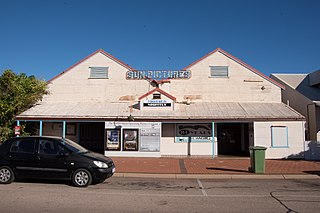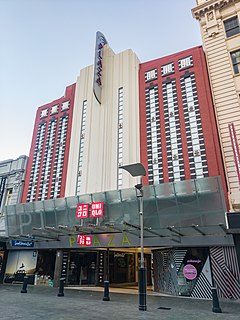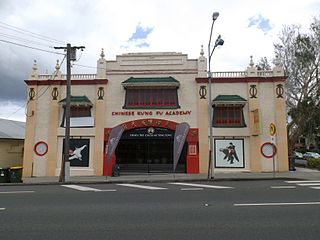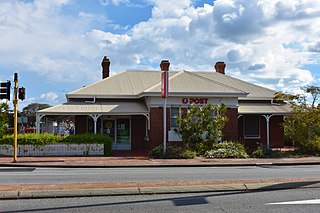
The Capitol is an historic theatre on Swanston Street in the central business district (CBD) of Melbourne, Victoria, Australia. Opened in 1924 as part of the Capitol House building, the art deco theatre was designed by American husband and wife architects Walter Burley and Marion Mahony Griffin, and is the oldest of Melbourne's large picture palaces. It is famous for its extravagant decor and abstract motifs, including an intricate geometric ceiling containing thousands of coloured lamps, designed to evoke the walls of a crystalline cave.

Nedlands is an affluent western suburb of Perth, Western Australia in the local government area of the City of Nedlands. It is about 7 kilometres (4 mi) from the Perth central business district via either Thomas Street or Mounts Bay Road.
Harold Boas was a town planner and architect in Western Australia. Boas designed many public buildings in and around Perth and was an influential Jewish community leader.

Cygnet Cinema is located at 16 Preston Street, Como, Western Australia. It was the first purpose built sound cinema in the suburbs immediately south of the city in the inter-war period. The Cygnet Cinema opened in 1938 and was built by local identity and film entrepreneur James Stiles. It is an excellent example of the art deco style of architect William Leighton and is included on the State's Heritage Register.

The Astor Theatre is located at 659 Beaufort Street, Mount Lawley, Western Australia. It comprises a single, two and three-storey masonry Inter-war Art Deco style theatre and retail building.
Thomas James Snooks (1890–1958) was a pioneering picture-show man and a developer-builder in the north-eastern suburbs of Perth, Western Australia. In addition to his professional interest in cabinet-making and building, Tom possessed a love for live theatre, staging a number of Gilbert and Sullivan productions in the Maylands Methodist hall, when he was in his early twenties. Not long after the First World War he began showing silent films at a number of venues in Maylands - at the Maylands town hall and the old Lyric Theatre - as well as in Bassendean, and Inglewood, under the business name Central Pictures. By staggering the starting times, Tom and his brothers were able to shuffle canisters of film between competing venues via a speeding motor cycle, thereby keeping the local police force on its toes. In the early days, Tom would go on stage to introduce the silent films, as he believed in the power of the word as well as the image.
Palace Cinemas is the fifth largest major cinema chain in Australia, with various locations in CBD and inner suburban areas of most capital cities. Palace Cinemas currently comprises 24 cinemas with 180 screens and more than 550 staff. Its head office is based in the Melbourne suburb of South Yarra, close to its Cinema Como flagship.
William Garnsworthy Bennett was a Western Australian architect, well known for his Art Deco and Inter-War Functionalist style of civic, commercial and domestic buildings, including the Lord Forrest Olympic Pool in Kalgoorlie, the Beverley Town Hall, the Raffles Hotel and Plaza Theatre and Arcade in Perth.
William Thomas Leighton (1905–1990) was a Western Australian architect, well known for his Art Deco and Inter-War Functionalist style of civic, commercial and domestic buildings.

The Piccadilly Cinema Centre and Piccadilly Arcade are located at 700-704 Hay Street, Perth, Western Australia. It is an art deco style cinema and shopping arcade, designed by architect William T. Leighton for mining entrepreneur Claude de Bernales. The theatre and arcade opened in 1938, with the arcade connecting Hay Street through to Murray Street.

The Sun Picture Gardens is the world's oldest picture gardens still in operation. It is located in Broome, Western Australia. Unlike most outdoor cinemas, it screens multiple films per night; the majority of outdoor cinemas screen one or two films a week.

Luna Leederville is a cinema complex located at the corner of Oxford and Vincent Streets in Leederville, a suburb of Perth, Western Australia.

The former Plaza Theatre is located at 650–658 Hay Street, Perth, Western Australia. It was the first purpose-designed Art Deco cinema in Perth. The Plaza Theatre opened in 1937 and was built for Hoyts Theatres Ltd.

The Oriana Cinema was an art deco cinema and theatre built in 1938 in Fremantle, Western Australia and demolished in the early 1970s.

Triumph Cinema is a heritage-listed former cinema at 963 Stanley Street, East Brisbane, City of Brisbane, Queensland, Australia. It was designed by Arthur Robson and built in 1927. It is also known as East Brisbane Picture Theatre, Elite Cinema, and Classic Cinema. It was added to the Queensland Heritage Register on 27 July 2001.
The Grand Theatre was a theatre and cinema located at 164–168 Murray Street, Perth, Western Australia. It was opened in September 1916 and closed in November 1980. The building was demolished in March 1990.

The Scone Civic Theatre is a heritage-listed cinema at 144 Kelly Street, Scone, Upper Hunter Shire, New South Wales, Australia. It was designed by Guy Crick and Bruce Furse and built from 1937 to 1938 by Mr A. F. Little. The property is privately owned. It was added to the New South Wales State Heritage Register on 21 February 2003.

Regent Theatre is a heritage-listed former theatre and cinema at 197 Keira Street, Wollongong, City of Wollongong, New South Wales, Australia. It was designed by Reginald J. Magoffin with an interior by Marion Hall Best and built from 1950 to 1954. It was added to the New South Wales State Heritage Register on 9 May 2005.

South Perth Post Office is a heritage-listed post office at 103 Mill Point Road, South Perth, Western Australia, Australia. It was added to the Australian Commonwealth Heritage List on 8 November 2011.














